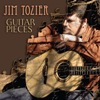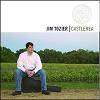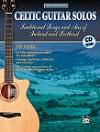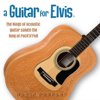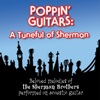| FAQ |
| Playing |
A: I started when I was 14; I got my first guitar for Christmas in 1984. I spent the next 18 years playing electric guitar in rock bands or playing acoustic as a singer-songwriter. Instrumental fingerstyle guitar didn't become my primary focus until 2002. Q: Do you have any formal training?
A: Not really. I took a semester of classical guitar in college (I wasn't very good), and took a few lessons with Al Petteway and one with El McMeen. Most of my previous learning was independent and very informal... I'd read books and watch other players and try to soak up as much as I could. It wasn't really an efficient approach, because there was no structure and no direction. I'd learn just enough to accomplish my immediate goals, but I missed out on a lot of valuable information that I had to go back and learn much later. Q: How often do you practice?
A: Truly practice? Not very often at all. I don't spend much time sitting down and consciously trying to improve my technique, for example. I don't practice scales or run through any sort of exercises on a regular basis. Part of the reason for this is that I have a limited amount of time to spend on playing guitar, and I'd rather use that time working on composing or arranging. I think it also reflects the fact that I don't really consider myself a "guitarist" as much as a songwriter who happens to play guitar. In other words, I'm more interested in using the guitar as a creative outlet than I am in mastering the instrument. Q: What got you interested in solo fingerstyle guitar?
A: Originally, it was hearing Michael Hedges' Aerial Boundaries... and his song "Bensusan" led me to discover Pierre's music as well. I was 15 or 16 at the time, and these guys just blew me away. I thought I was a decent fingerpicker because I had the Travis picking technique down, but Hedges and Bensusan opened up a whole new world of possibilities for me.
Around the same time, my uncle started taking me to The King of France Tavern in Annapolis to see Charlie Byrd play. The first time I went I really didn't know who he was, but his playing absolutely mesmerized me. My uncle knew Charlie personally, so between sets he'd come over and sit at our table and chat for a bit. Those conversations with Charlie made quite an impression on me. Although it was Hedges, Bensusan and Byrd who got me to start dabbling around with fingerstyle guitar, I was mainly playing in bands during my teens and twenties, and it wasn't until I saw Al Petteway get pulled up on stage to play a few songs at a David Wilcox concert in 2002 that I really decided to focus on fingerstyle. As soon as I heard Al play, I knew that was the kind of music I wanted to do. And since the long-time band I was in had dissolved, I finally had the time to dedicate myself to it. Q: What tunings do you use?
A: DADGAD has become my "standard" tuning. I use it more often than any tuning, and will often stick to DADGAD on stage when doing shorter performances. My other favorite tunings are CGDGAD and CGCGCD. I've also used slight variations of these three tunings on a few songs: DGDGAD, CGCGCE, and CGCGCEb. Q: It looks like you only use a few right-hand fingers for picking. How did you develop that style?
A: When I first starting doing Travis-style picking, I only used the thumb plus the index and middle fingers. I did a lot of picking patterns over chord changes when playing in bands and the three-finger approach became a habit. In fact, one of the reasons I struggled so much with classical guitar was my inability to use the ring finger and pinky with any sort of consistency. I basically would have had to start over from scratch in learning right-hand technique, and I was too stubborn to do that. Still am, I guess, since I still use just three fingers most of the time. The only real exception is if I'm plucking multiple strings of a chord at the same time. Q: Do you use natural nails or acrylics?
A: I use my natural nails, but I keep them shorter than most players. My nails aren't that strong, and they tend to chip or fray if they get too long. I've thought about acrylic nails, but haven't tried them yet. Since I like a very warm, round sound, I'd actually prefer to follow Laurence Juber's example and use fingertips only, but I'm not quite ready to make that commitment yet. Q: Do you use a thumb pick?
A: No. I've gone through several periods where I've tried them, but I keep finding that I don't like the feel (or rather, the lack of feel) when using one, and I actually prefer the tone when using my thumb. A thumb pick gives me more volume, but it also yields a brighter attack with a little more "zing" to it, and I like my bass notes to be very fat and round. I also like the melody to be out on top of the bass a little bit more; when I use a thumb pick, the bass tends to step up to compete with the melody rather than accompany it. I'm sure that adjusting my technique could fix that, but I already have the balance I like without using a thumb pick. Even though forsaking the thumb pick means sacrificing some volume, I'm happier with the tone. Q: Much of your style seems to come from left-hand technique--specifically hammer-ons and pull-offs. Do you have any advice for improving these techniques?
A: One of the reasons I use them so often is that they tend to come pretty naturally for me. I've had several students, though, that have really struggled with them, and I think there are a couple of suggestions to keep in mind when working on hammers and pulls. First, slow down and focus on making sure that you're executing them cleanly. In other words, both notes in the hammer or pull should sound clearly and at the same volume. Keeping the same volume shouldn't mean you have to execute the hammers and pulls with more force--just better technique. Don't worry about doing them fast, either... the speed will come naturally once you've got the right technique. It's more important to execute hammers and pulls cleanly rather than quickly. The second suggestion is to get all four left-hand fingers involved. You should be able to use any combination of fingers (even the pinky!) for both hammers and pulls without losing clarity or volume. Q: I notice that sometimes during performances you play standing up, and other times you play sitting down. Do you have a preference?
A: Not really. I think it has more to do with the type of performance I'm doing than anything else. The decision usually depends on the venue, the stage area, the type of audience, the sound system (if any), etc. Fingerstyle guitarists tend to prefer playing seated, but since I spent so many years playing electric guitar, standing while playing feels completely natural and comfortable. Q: Do you play any other types of music?
A: I still like to pick up an electric guitar every once in a while and play the blues or dabble in a bit of jazz. And I still enjoy grabbing an acoustic in standard tuning and strumming (and singing) all the songs I wrote for my old band. But playing solo fingerstyle guitar is challenging enough and rewarding enough to keep me occupied and satisfied.

